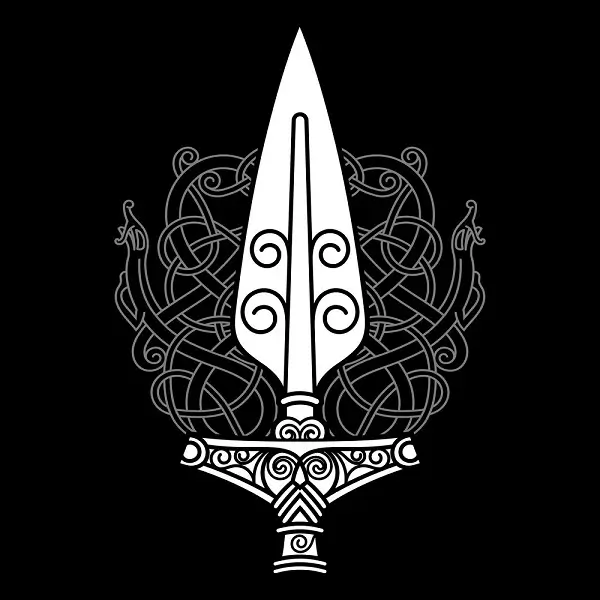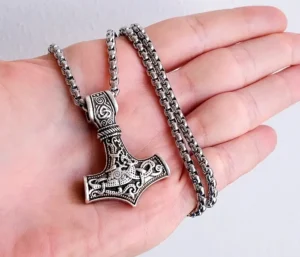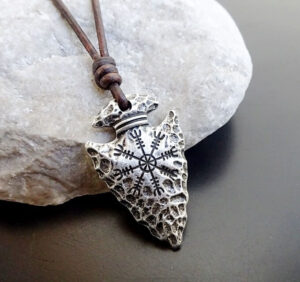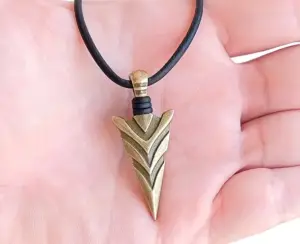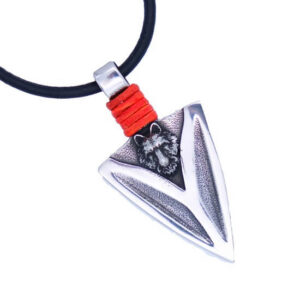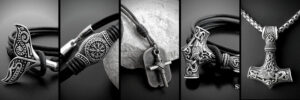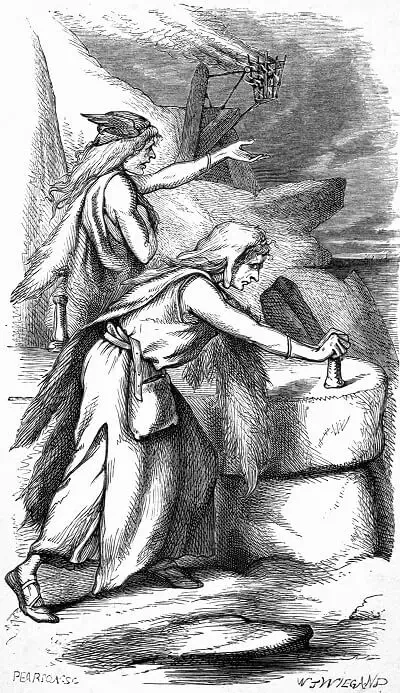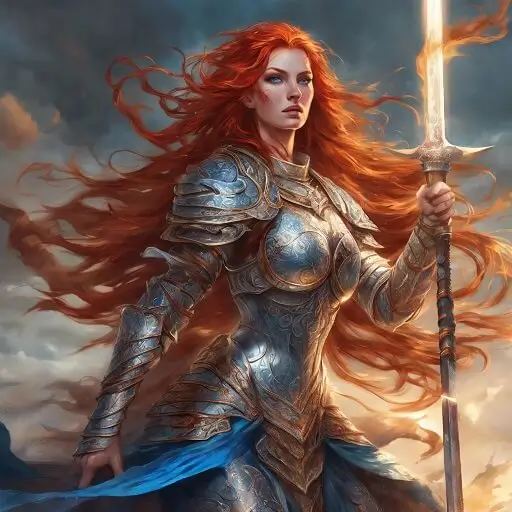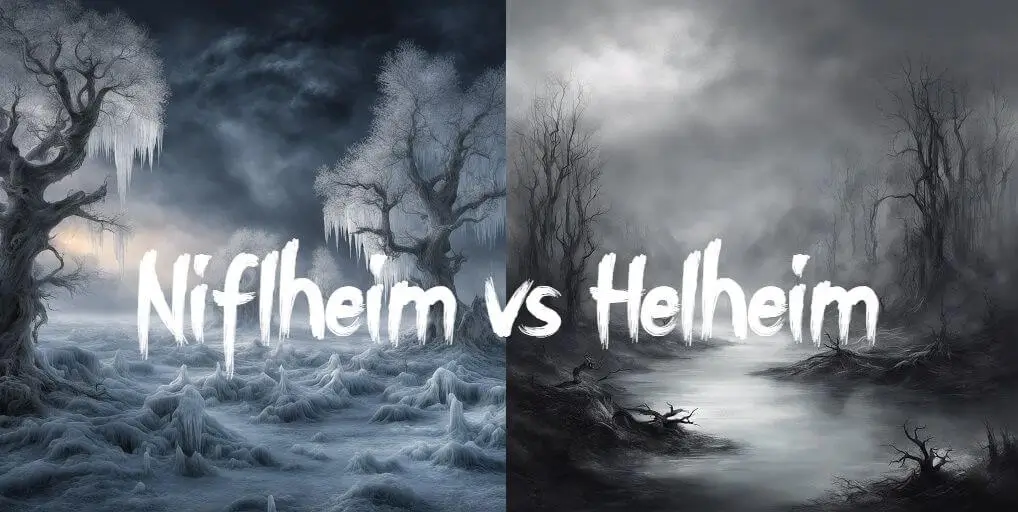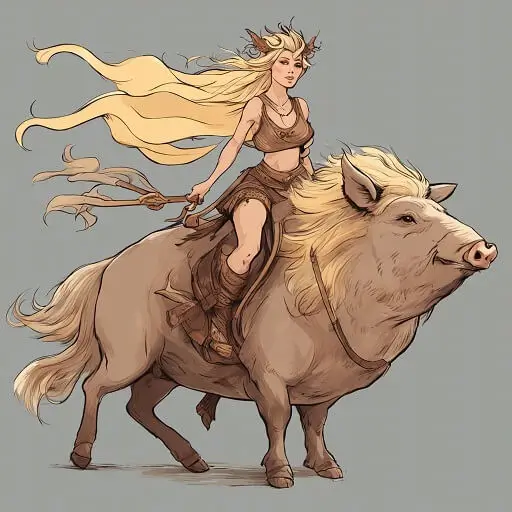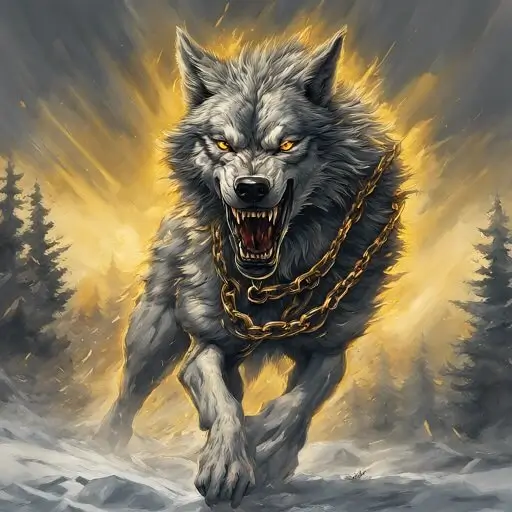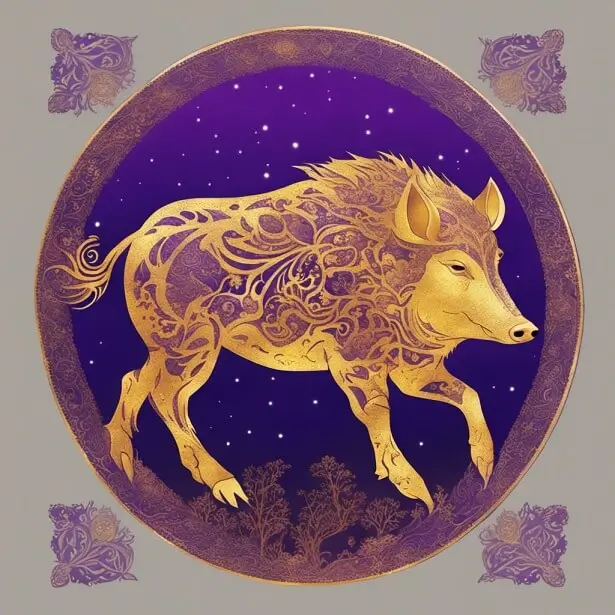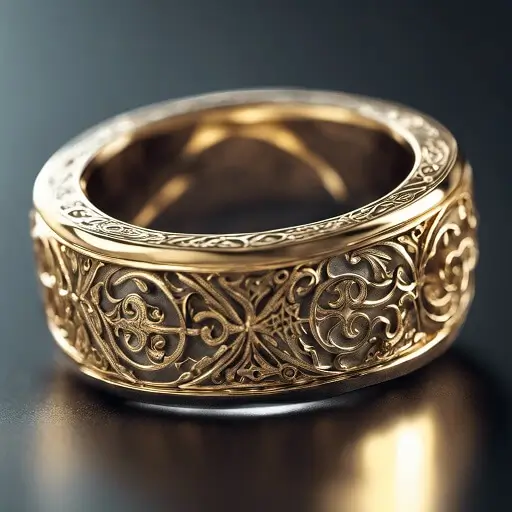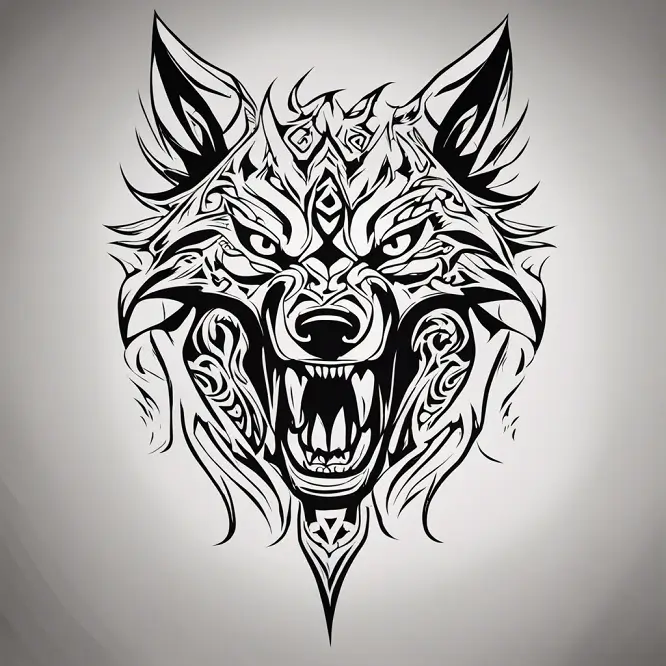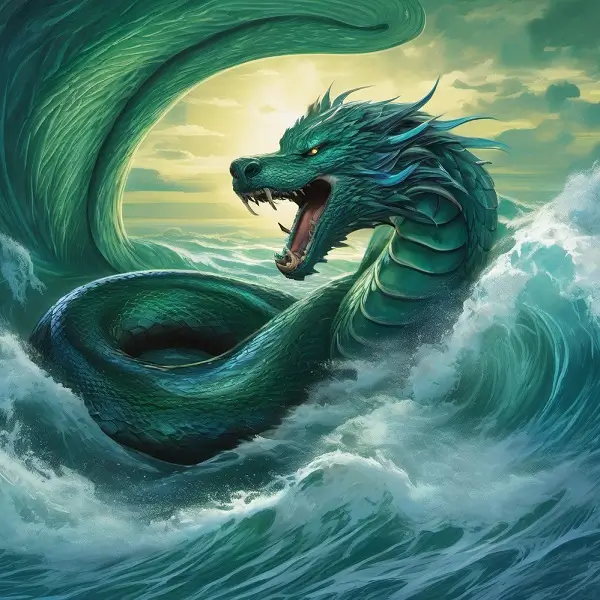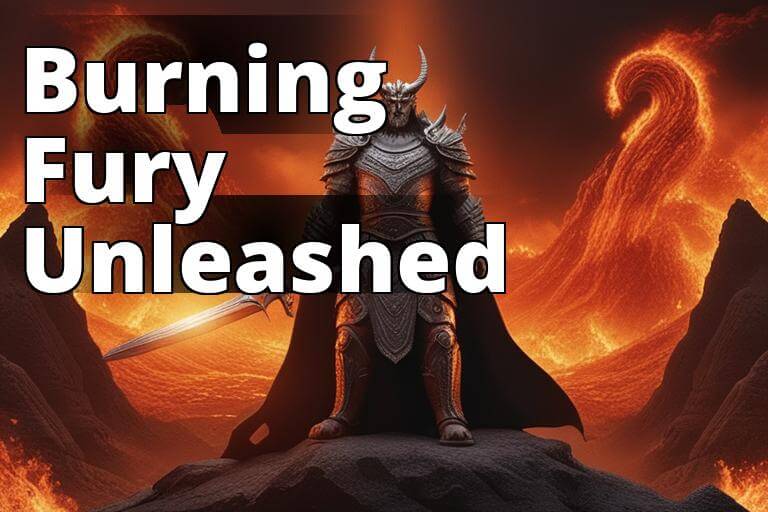In Norse mythology, no weapon is more iconic and storied than Gungnir, the magical spear wielded by Odin, ruler of the Aesir gods and lord of Asgard.
This legendary weapon has been featured prominently across Norse mythological tales, poetry, and Viking artistic depictions. Its origins, powers, symbolism and role in Norse culture reveal why Gungnir is one of the most revered artifacts in the Viking pantheon.
Key Facts About Gungnir
- Gungnir means “the swaying one” in Old Norse, referring to its erratic movements in battle.
- It was forged by expert dwarven blacksmiths and gifted to Odin, who treasured it above all weapons.
- The spear would always hit its target, regardless of the wielder’s skill. Its balance was said to be perfect.
- Runes were carved on Gungnir’s tip, imbuing it with magical power and accuracy.
- It symbolized Odin’s power, authority, knowledge, warfare capabilities and connection to the divine.
- Gungnir played a crucial role in mythological battles and was used to invoke Odin’s aid in real Viking combat.
- The spear features prominently in poetry, sagas, art and rituals honoring Odin in the Viking Age.
- Its legacy continues today, with Gungnir inspiring everything from Marvel comics to video games to Neo-pagan symbolism.
The Legendary Origins of Gungnir
In Norse mythology, Gungnir’s origins lie with the legendary race of dwarves, who fashioned this impressive spear just for Odin.
The Poetic Edda describes how the trickster god Loki cut off the golden hair of Thor’s wife Sif, for which he had to make amends. He approached the Sons of Ivaldi, master dwarven craftsmen, and commissioned them to replace Sif’s hair with magical strands of pure gold.
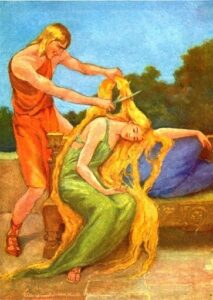
Sif and Loki 1930 Katharine Pyle
Impressed by their work, and perhaps scheming to sow more mischief, Loki daringly challenged the dwarves to create more magnificent gifts for the gods. The dwarves accepted and made a ship and boar for Freyr, as well as a hammer for Thor. But the most wondrous item was a spear, Gungnir, which Loki immediately claimed for Odin.
Mjolnir Thor’s Hammer
When presenting Gungnir to Odin, Loki boasted that the spear would always hit its target, no matter how poorly it was aimed. He also claimed that any oaths sworn upon its tip could never be broken – a testament to the honor of dwarven craftsmanship. Odin happily accepted it as his weapon of choice.
Other myths suggest Gungnir was forged from sunlight or carved from the mystical World Tree Yggdrasil itself. Its dazzling appearance and perfect balance were divine qualities that set it apart from mundane weapons. Clearly, this was no ordinary spear – it was a fit weapon for the king of the gods.
The Power and Symbolism of Gungnir
In the myths, Gungnir is portrayed as much more than just a physical spear. It is infused with aspects of Odin’s power and personality.
For the Vikings, spears symbolized strength, masculinity and authority. As Odin is the epitome of these qualities as the preeminent Norse god, Gungnir amplifies the magnitude of his power. It acts as an extension of his force of will.
The spear’s runic carvings link it to Odin’s unmatched intelligence, wisdom and mastery of magic, which allowed him to discover the secret runic alphabet. Gungnir’s unerring accuracy reflects how Odin’s far-reaching knowledge lets him plan for any eventuality and respond accordingly.
Since Odin is closely associated with battle, victory and violent death, Gungnir echoes these attributes. Its swaying, erratic movements in combat mirror the chaos and madness of war, over which Odin presides.
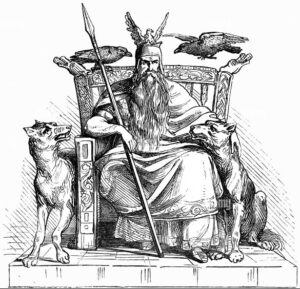
Odin with geri and freki, Huginn and Muninn and with his mighty spear Gungnir
Yet Gungnir also represents the order and structure that Odin creates from this chaos. Its perfect balance and ability to strike any target evoke Odin’s role as an organizer of the cosmos and arbitrator of fate.
Overall, Gungnir symbolically encapsulates Odin’s complex roles as a war deity, wise magician, and cosmic shepherd. It is a physical extension of his multifaceted nature.
Gungnir in the Norse Sagas and Poems
True to its mythical origins, Gungnir plays a starring role across Norse literature. It appears prominently in tales describing Odin, yet also shows up in all manner of scenes and settings.
The Völuspá poem in the Poetic Edda depicts the violent, world-ending battle of Ragnarok. As gods and monsters prepare to fight, Odin “comes armed, to the field, from Asgard.” Specifically, he advances carrying his spear Gungnir, armor and gold helmet.
In the prose Edda, Odin again wields Gungnir when leading the finest Viking warriors from Valhalla into the cataclysmic Ragnarok fray. With his magical spear in hand, Odin fiercely attacks his archenemy Fenrir, the apocalyptic wolf.
Earlier in the same work, readers learn just how Odin acquired Gungnir, thanks to the mischief of Loki and craft of the dwarves. This tale highlights the spear’s magical accuracy and indestructible nature.
Other sagas feature mortal heroes receiving Gungnir temporarily from Odin as a gift or reward. The spear usually ends up back with its true owner in short order. These stories emphasize how Gungnir allows Odin to subtly influence events.
The esteemed 10th century skaldic poet, Bragi Boddason, refers to Odin as the “Gungnir-shaker,” vividly invoking the spear’s role in warfare. Many additional kennings reference and praise Gungnir when describing Odin. Clearly, Gungnir was deeply intertwined with Odin’s poetic identity just as in the broader Norse myths.
Here is a chart summarizing Gungnir’s significant appearances in Norse literature:
| Source | Details |
|---|---|
| Völuspá | Odin wields Gungnir entering the battle at Ragnarok |
| Prose Edda | Odin carries Gungnir while fighting Fenrir wolf at Ragnarok; story covers Gungnir’s dwarven origins |
| Norse Sagas | Mortal heroes temporarily possess Gungnir when Odin allows it |
| Skaldic Poetry | Bragi Boddason refers to Odin as “Gungnir-shaker” |
| Kennings | Many kennings reference Gungnir when praising Odin |
Gungnir in Viking Culture and Rituals
Beyond literature, Gungnir appears regularly in Viking and earlier Germanic material culture in the form of artifacts, carvings and runestones.
A spear-wielding god who may be Odin is prominent on Ardre VIII, a picture stone from Gotland, Sweden dated from the 8th century CE.
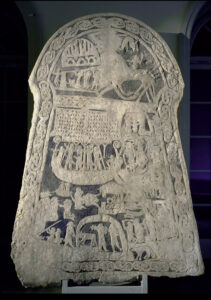
Ardre VIII stone
Another possible Odin figure carrying a spear and riding Sleipnir, Odin’s eight-legged horse, is inscribed on the 11th century CE Tängelgårda stone from Sweden.
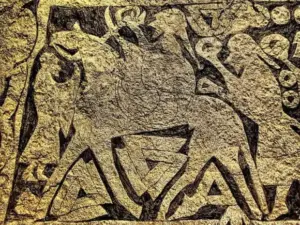
Tangelgarda
The Böksta Runestone, carved in Sweden during the 7th century CE, features a rider carrying a spear and riding after an animal, generally interpreted as Odin with Gungnir hunting after an elk or stag. It is one of the oldest depictions of Odin and Gungnir.
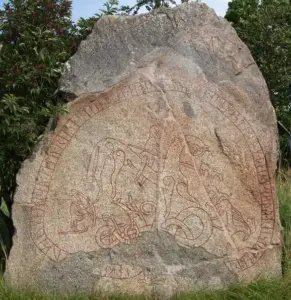
Actual Viking Age iron spearheads have been discovered in Scandinavia engraved with runes invoking Odin’s name. This suggests the historical Norse attempted to channel the accuracy and potency of Gungnir by magically carving runes onto their own weapons.
In Viking rituals, just as Odin initiated the mythological Aesir-Vanir War by hurling his spear over the enemy host, Viking warriors would likewise hurl a spear over their foes while invoking Odin.
This act dedicated the imminent battle to Odin, consecrated the battlefield to him, and invoked his aid in gaining victory.
When making ritual human sacrifices to Odin, such as during a coronation or public execution, Vikings would repeat Odin’s own self-sacrifice by impaling the victim on a spear.
Hanging or other forms of execution were also practiced in combinations recalling Odin’s mythic quest for knowledge. The prominent role of the spear in these rites clearly connects them to Odin’s weapon Gungnir.
The Legends of Gungnir in Norse Mythology
In Norse mythology, the legendary spear Gungnir is intricately linked to the exploits and adventures of its owner, Odin. Several prominent stories shed light on its importance.
The Aesir-Vanir War and Gungnir
According to legend, the violent Aesir gods once clashed with the more peaceful Vanir deities. Before marching into battle, Odin symbolically initiated the conflict by hurling his spear Gungnir over the ranks of Vanir, bellowing “Odin owns you all!”
Though Odin eventually made peace with the Vanir, this iconic act was mimicked by Viking warriors, who would similarly hurl spears while invoking Odin’s name to ensure victory.
Scholars believe this ritual spear throwing consecrated the battlefield to Odin and offered the lives taken in combat as a sacrifice to him.
Odin’s Quest for Wisdom and Gungnir
Odin was renowned as much for his unquenchable thirst for wisdom as for warmongering. Myth tells that he sacrificed himself to himself on the World Tree Yggdrasil, grievously piercing himself with his spear Gungnir before hanging himself from the tree’s boughs for nine days.
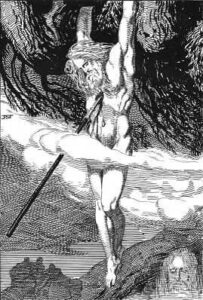
When Odin emerged, he had obtained the forbidden runic knowledge he craved so fiercely. This myth of death and rebirth through spear and tree is thought to be symbolically recreated when victims were ritually sacrificed to Odin through spear-stabbing and in combination with forms of hanging.
Ragnarok and Gungnir
In the apocalyptic legend of Ragnarok, when gods and monsters meet on the field of battle for mutual annihilation, Odin leads the charge wielding Gungnir as always.
He first uses the spear to viciously attack his ancient nemesis, the wolf Fenrir. Though Odin falls, in this climactic story, Gungnir serves as a powerful symbol of resistance in the face of inevitable doom.
The god who ruled thanks to his mighty spear could not forestall tragedy, but went down fighting nonetheless.
These key tales reinforce why no icon was more closely associated with Odin than his peerless spear Gungnir. Its role pervades both mythology and the reality of Viking rituals and battle.
Through these stories, Gungnir’s symbolic importance and connection to Odin is made legendary.
Gungnir in the Viking Age
| Context | Significance |
|---|---|
| Viking Art | Frequently depicted in artworks like picture stones and runestones, as early as the 7th century Böksta Runestone |
| Viking Spearheads | Found engraved with runes invoking Gungnir to channel its power |
| Viking Battles | Warriors would hurl spears and invoke Odin before battles, copying Odin starting the Aesir-Vanir War |
| Ritual Sacrifices | Spears used for human sacrifices to Odin, mimicking his self-sacrifice for runes |
Modern Influences and Pop Culture
Thanks to renewed fascination with ancient Norse mythology, Gungnir continues to be a prominent symbol and story element today. It features in myriad pop culture sources, from high fantasy epics to comic books to video games.
In Marvel’s Thor comics and the Marvel Cinematic Universe films, Odin carries a golden spear recognizable as Gungnir. It is depicted as a fit weapon for a king, used to channel power or as an authoritative symbol. Loki briefly claims Gungnir after usurping Odin’s throne.
The anime and manga series Noragami revolves around supernatural Regalia weapons imbued with spirits, including one named Gungnir. Weapons in the Final Fantasy game franchise use the name Gungnir.
The spear Thorn appears in novels and games based on C.S. Lewis’ Space Trilogy. Fantasy author Rick Riordan has featured a version of Gungnir in his Magnus Chase books.
Many works of art depict Odin and Gungnir, or scenes and characters from Norse myths involving the legendary spear. These range from 19th century illustrations and paintings to modern comics stylings.
Neo-pagan religions and magical practices based on Norse tradition may use ritual representations of Gungnir in ceremonies and iconography. This further reflects the weapon’s continuity as a symbol of Odin’s power.
Gungnir also lends its name to boats, sports teams, weapons manufacturers and more as an iconic element of Norse heritage. Millennia after its origins in myth, the spear remains culturally ubiquitous.
Gungnir in Modern Culture
| Context | Example |
|---|---|
| Marvel Comics/Movies | Appears as Odin’s weapon |
| Anime and Video Games | Seen in series like Noragami and Final Fantasy |
| Novels | Appears in Magnus Chase book series |
| Artworks | Inspires art depicting Norse myths and Odin |
| Neopagan Religions | Used in Norse pagan/magic rituals and ceremonies |
| Branding and Names | Lends name to sports teams, ships, weapons manufacturers |
Frequently Asked Questions About Gungnir
What did Gungnir look like? Was it ornately decorated?
The exact physical appearance of Gungnir is not definitively described. It was likely a typical Viking Age spear, though some think it may have had ornate decorations or inscriptions since it belonged to Odin.
Why was Gungnir Odin’s favored weapon?
Its perfect balance, magical accuracy, and divine runes imbued it with great power. As the chief god’s weapon, it channeled his authority and abilities.
How was Gungnir forged and given its powers?
The dwarves created it using their exceptional smithing skills and spells. Its solar origins may also have contributed to its potency.
What limits did Gungnir have regarding what it could penetrate?
Gungnir could reputedly pierce any surface or armor. However, even it failed against some powerful magical forces and beings.
What magical powers did Gungnir’s runes invoke?
The runes likely invoked accuracy, strength, and victory. Their secrets died with Odin, but all who wielded Gungnir could benefit from them.
Did Gungnir survive Ragnarok?
It’s unknown. Some believe as the greatest spear in the cosmos it must have endured, but others think all traces of the old gods’ world perished.
How did Mjolnir compare to Gungnir?
Mjolnir symbolized Thor’s strength whereas Gungnir embodied Odin’s authority and wisdom. Both were unmatched ceremonial weapons.
What abilities did Gungnir grant its wielder?
Infallible accuracy and piercing power. Possibly control over weather/elements and power to channel runic magic.
Was Gungnir the most powerful weapon in Norse myth?
Gungnir, Mjolnir and Tyrfing all have claims to this title. Each channeled specific facets of power. But Gungnir’s runes may have set it apart.
Who besides Odin used Gungnir?
Valkyrie Brynhildr and the human hero Sigurd possessed it briefly. But Odin always reclaimed it swiftly. He did not lightly share his prized spear.
Did Gungnir have any weaknesses or limitations?
None are mentioned in the original sources. Even after Ragnarok it may have retained its powers. But Odin meets his fate regardless of Gungnir’s might.
Conclusion
For the ancient Norse, no weapon was more central than Odin’s mighty spear Gungnir. Its stellar craftsmanship and magical qualities made it invaluable among the Aesir god’s possessions, while the prominent role it played across Norse mythic history cemented its legacy.
Beyond its literal purpose as Odin’s weapon of choice, Gungnir took on deeper symbolic significance in the Norse consciousness. Its qualities and actions in the sagas encapsulated Odin’s main spheres of influence, while its prominent role in rituals further linked it to Odin’s cultic worship.
Today, centuries past the end of the Viking Age, Gungnir remains an iconic element of Norse mythology and culture. It is one of the enduring symbols of Odin’s power and knowledge that still captures the popular imagination through continued modern retellings, reinventings and depictions. For all these reasons, Gungnir’s mystique and appeal is truly ageless.
Shop Norse Jewelry
Are passionate about Norse Mythology?
Finding the ideal piece of Norse Jewelry can be challenging and time-consuming, especially if you lack inspiration or don’t know where to look.
Surflegacy, has you covered. We have a wide range of Handmade Jewelry in various styles, shapes, colors, and materials, to accentuate your Norse spirit and look. Do not hesitate to visit our selection HERE
Whatever you wear, you’ll find the ideal trendy piece to complement your wardrobe. Our jewelry is designed to be worn every day, no matter where you go or what season is. Are you ready to step up your wardrobe game?

